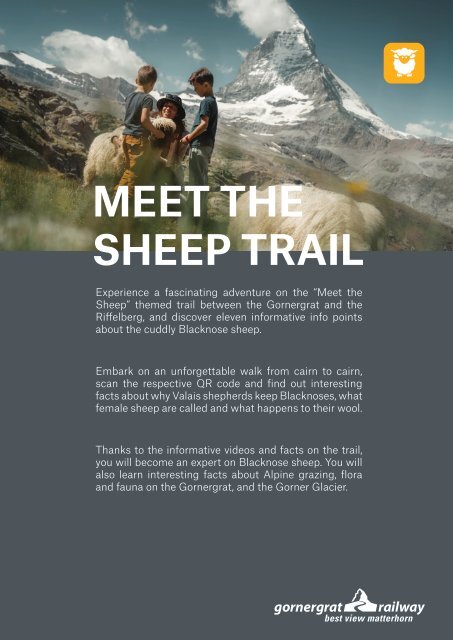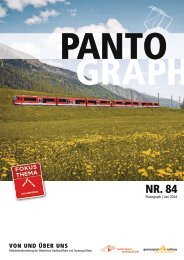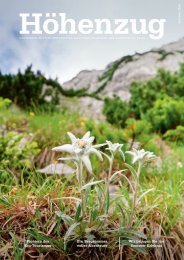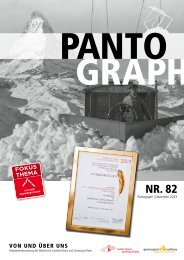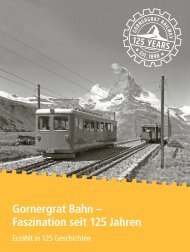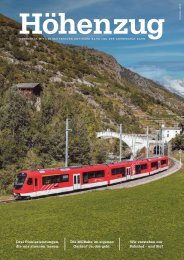Meet the Sheep themed trail on the Gornergrat
The themed trail around the black-nosed sheep on the Gornergrat. Complete the themed trail from Gornergrat to Riffelberg and answer the quiz questions at gornergrat.ch/meet-the-sheep. Win a weekend in Zermatt.
The themed trail around the black-nosed sheep on the Gornergrat. Complete the themed trail from Gornergrat to Riffelberg and answer the quiz questions at gornergrat.ch/meet-the-sheep. Win a weekend in Zermatt.
You also want an ePaper? Increase the reach of your titles
YUMPU automatically turns print PDFs into web optimized ePapers that Google loves.
Info point 2<br />
MEET THE<br />
SHEEP TRAIL<br />
Experience a fascinating adventure <strong>on</strong> <str<strong>on</strong>g>the</str<strong>on</strong>g> “<str<strong>on</strong>g>Meet</str<strong>on</strong>g> <str<strong>on</strong>g>the</str<strong>on</strong>g><br />
<str<strong>on</strong>g>Sheep</str<strong>on</strong>g>” <str<strong>on</strong>g>the</str<strong>on</strong>g>med <str<strong>on</strong>g>trail</str<strong>on</strong>g> between <str<strong>on</strong>g>the</str<strong>on</strong>g> <strong>Gornergrat</strong> and <str<strong>on</strong>g>the</str<strong>on</strong>g><br />
Riffelberg, and discover eleven informative info points<br />
about <str<strong>on</strong>g>the</str<strong>on</strong>g> cuddly Blacknose sheep.<br />
Embark <strong>on</strong> an unforgettable walk from cairn to cairn,<br />
scan <str<strong>on</strong>g>the</str<strong>on</strong>g> respective QR code and find out interesting<br />
facts about why Valais shepherds keep Blacknoses, what<br />
female sheep are called and what happens to <str<strong>on</strong>g>the</str<strong>on</strong>g>ir wool.<br />
Thanks to <str<strong>on</strong>g>the</str<strong>on</strong>g> informative videos and facts <strong>on</strong> <str<strong>on</strong>g>the</str<strong>on</strong>g> <str<strong>on</strong>g>trail</str<strong>on</strong>g>,<br />
you will become an expert <strong>on</strong> Blacknose sheep. You will<br />
also learn interesting facts about Alpine grazing, flora<br />
and fauna <strong>on</strong> <str<strong>on</strong>g>the</str<strong>on</strong>g> <strong>Gornergrat</strong>, and <str<strong>on</strong>g>the</str<strong>on</strong>g> Gorner Glacier.
Info point 1<br />
THE BLACKNOSE SHEEP –<br />
TRADITION AND ADAPTATION<br />
IN VALAIS<br />
Welcome to <str<strong>on</strong>g>the</str<strong>on</strong>g> “<str<strong>on</strong>g>Meet</str<strong>on</strong>g> <str<strong>on</strong>g>the</str<strong>on</strong>g> <str<strong>on</strong>g>Sheep</str<strong>on</strong>g>” <str<strong>on</strong>g>the</str<strong>on</strong>g>med <str<strong>on</strong>g>trail</str<strong>on</strong>g>!<br />
We’re delighted that you’re taking part in this adventure.
Info point 1<br />
Have you already enjoyed o<str<strong>on</strong>g>the</str<strong>on</strong>g>r offers <strong>on</strong> <str<strong>on</strong>g>the</str<strong>on</strong>g> <strong>Gornergrat</strong>?<br />
What about a visit to <str<strong>on</strong>g>the</str<strong>on</strong>g> interactive exhibiti<strong>on</strong><br />
“ZOOOM <str<strong>on</strong>g>the</str<strong>on</strong>g> Matterhorn”? Here you can experience<br />
<str<strong>on</strong>g>the</str<strong>on</strong>g> Matterhorn and <str<strong>on</strong>g>the</str<strong>on</strong>g> surrounding mountains and<br />
glaciers up close from afar. And d<strong>on</strong>’t forget to take a<br />
souvenir photo at <str<strong>on</strong>g>the</str<strong>on</strong>g> Photopoint next to <str<strong>on</strong>g>the</str<strong>on</strong>g> summit<br />
stati<strong>on</strong>!<br />
Blacknose sheep are a l<strong>on</strong>g-standing traditi<strong>on</strong> in<br />
Valais. But why exactly Blacknoses? The Blacknose<br />
shepherds in Upper Valais usually take over breeding<br />
from <str<strong>on</strong>g>the</str<strong>on</strong>g>ir fa<str<strong>on</strong>g>the</str<strong>on</strong>g>rs. It is often a family matter whe<str<strong>on</strong>g>the</str<strong>on</strong>g>r<br />
you keep Blacknose sheep or o<str<strong>on</strong>g>the</str<strong>on</strong>g>r types of sheep.<br />
Blacknose sheep are adaptable and used to <str<strong>on</strong>g>the</str<strong>on</strong>g> harsh<br />
c<strong>on</strong>diti<strong>on</strong>s in <str<strong>on</strong>g>the</str<strong>on</strong>g> high mountains. They are robust and<br />
undemanding, and <str<strong>on</strong>g>the</str<strong>on</strong>g>refore fit perfectly into <str<strong>on</strong>g>the</str<strong>on</strong>g> Upper<br />
Valais regi<strong>on</strong>. For a l<strong>on</strong>g time, <str<strong>on</strong>g>the</str<strong>on</strong>g> breed of Blacknose<br />
sheep was c<strong>on</strong>sidered threatened with extincti<strong>on</strong>,<br />
as it was almost completely supplanted by o<str<strong>on</strong>g>the</str<strong>on</strong>g>r<br />
sheep species in <str<strong>on</strong>g>the</str<strong>on</strong>g> last decades of <str<strong>on</strong>g>the</str<strong>on</strong>g> twentieth<br />
century. Instead, many farmers bred sheep that had<br />
better meat or a better quality of wool or were simply<br />
more ec<strong>on</strong>omically viable.
Info point 2<br />
BUILD THE HIGHEST<br />
CAIRN<br />
Welcome to <str<strong>on</strong>g>the</str<strong>on</strong>g> most beautiful challenge <strong>on</strong> <str<strong>on</strong>g>the</str<strong>on</strong>g><br />
<strong>Gornergrat</strong>! Have you discovered any of <str<strong>on</strong>g>the</str<strong>on</strong>g> cairns<br />
yet?
Info point 2<br />
Cairns are a world-famous phenomen<strong>on</strong> that have<br />
been used for a variety of purposes for centuries. In<br />
South America <str<strong>on</strong>g>the</str<strong>on</strong>g>y served as places of worship for<br />
<str<strong>on</strong>g>the</str<strong>on</strong>g> deity “Pachamama” and marked paths, while in<br />
Greece <str<strong>on</strong>g>the</str<strong>on</strong>g>y served as signposts for hikers and in<br />
Scandinavia <str<strong>on</strong>g>the</str<strong>on</strong>g>y fended off trolls. Are you ready to<br />
build <str<strong>on</strong>g>the</str<strong>on</strong>g> highest cairn?<br />
Are you also enjoying <str<strong>on</strong>g>the</str<strong>on</strong>g> breathtaking mountain panorama?<br />
It is not <str<strong>on</strong>g>the</str<strong>on</strong>g> same for <str<strong>on</strong>g>the</str<strong>on</strong>g> Blacknose sheep, as<br />
<str<strong>on</strong>g>the</str<strong>on</strong>g>y can hardly see anything due to <str<strong>on</strong>g>the</str<strong>on</strong>g> l<strong>on</strong>g wool over<br />
<str<strong>on</strong>g>the</str<strong>on</strong>g>ir eyes. Watch <str<strong>on</strong>g>the</str<strong>on</strong>g> following video to see how <str<strong>on</strong>g>the</str<strong>on</strong>g><br />
sheep are shorn:<br />
www.youtube.com
Info point 3<br />
Fascinating facts and<br />
figures about <str<strong>on</strong>g>the</str<strong>on</strong>g><br />
fluffy gregarious animals<br />
The Blacknose sheep are real eyecatchers. Become<br />
an expert <strong>on</strong> Blacknose sheep!
Info point 3<br />
Facts and figures about <str<strong>on</strong>g>the</str<strong>on</strong>g> sheep:<br />
• Blacknose sheep all have horns, both females and<br />
males.<br />
• Here <strong>on</strong> <str<strong>on</strong>g>the</str<strong>on</strong>g> <strong>Gornergrat</strong> you will see a flock of females.<br />
The rams are not allowed to go to <str<strong>on</strong>g>the</str<strong>on</strong>g> alp.<br />
This avoids fighting over a group of females.<br />
• Blacknose sheep d<strong>on</strong>’t like being milked and d<strong>on</strong>’t<br />
give enough milk to be able to use it.<br />
• The horns grow throughout <str<strong>on</strong>g>the</str<strong>on</strong>g>ir lifetime. The horns<br />
give an indicati<strong>on</strong> of <str<strong>on</strong>g>the</str<strong>on</strong>g> approximate age of an animal.<br />
• Blacknose sheep are gregarious and should be kept<br />
in a group of at least four animals.<br />
• The female sheep are called ewes. A full-grown ram<br />
can be kept with a maximum of 15 ewes.<br />
• Blacknose sheep mature late, i.e. rams at about 5 – 6<br />
m<strong>on</strong>ths, ewes at about 7 m<strong>on</strong>ths. Never<str<strong>on</strong>g>the</str<strong>on</strong>g>less, <str<strong>on</strong>g>the</str<strong>on</strong>g><br />
first lambing should not take place before <str<strong>on</strong>g>the</str<strong>on</strong>g>y are<br />
18 m<strong>on</strong>ths old.<br />
• A lamb is c<strong>on</strong>sidered a lamb for up to 12 m<strong>on</strong>ths.<br />
The animals are used for meat at <str<strong>on</strong>g>the</str<strong>on</strong>g> age of 7 – 9<br />
m<strong>on</strong>ths at <str<strong>on</strong>g>the</str<strong>on</strong>g> earliest.
Info point 3<br />
• Births usually take place without any problems and<br />
without help. The Blacknose sheep give birth <strong>on</strong> average<br />
to 1.5 lambs per birth, so every sec<strong>on</strong>d sheep<br />
has twins. Triplets are very rare.<br />
• The young animals usually have <str<strong>on</strong>g>the</str<strong>on</strong>g>ir faces covered<br />
by <str<strong>on</strong>g>the</str<strong>on</strong>g>ir wool. But <str<strong>on</strong>g>the</str<strong>on</strong>g>y can still see well through <str<strong>on</strong>g>the</str<strong>on</strong>g><br />
wool – <str<strong>on</strong>g>the</str<strong>on</strong>g>y are used to it. It also protects <str<strong>on</strong>g>the</str<strong>on</strong>g>ir eyes<br />
from flies.<br />
• The wool is delivered to <str<strong>on</strong>g>the</str<strong>on</strong>g> domestic wool centre.<br />
The payment for <str<strong>on</strong>g>the</str<strong>on</strong>g> wool does not come close to<br />
covering <str<strong>on</strong>g>the</str<strong>on</strong>g> cost of shearing. You can find out more<br />
about how <str<strong>on</strong>g>the</str<strong>on</strong>g> wool is processed at info point 4.<br />
• The annual yield of wool per animal is around 4 kilograms.<br />
• The particularly tame and affecti<strong>on</strong>ate leaders of a<br />
flock usually wear bells.<br />
• The requirements for exporting Blacknose sheep<br />
from Switzerland are very high and are currently difficult<br />
or even impossible to meet.<br />
• A ewe weighs about 70 – 90 kilograms, a ram weighs<br />
about 80 – 125 kilograms.<br />
• The ewes are easy to recognise as <str<strong>on</strong>g>the</str<strong>on</strong>g>y have a mark<br />
<strong>on</strong> <str<strong>on</strong>g>the</str<strong>on</strong>g>ir tails. It is a white or light spot at <str<strong>on</strong>g>the</str<strong>on</strong>g> base of<br />
<str<strong>on</strong>g>the</str<strong>on</strong>g>ir tail.<br />
• The life expectancy of a Blacknose is 12 – 14 years.
Info point 4<br />
BUNDLES OF WOOL<br />
The Blacknose sheep are small, lively<br />
balls of wool. Putting your hands into <str<strong>on</strong>g>the</str<strong>on</strong>g>ir wool<br />
is a fantastic feeling. This renewable resource is<br />
much more than just fluffy, it is highly valuable and<br />
can be used in a variety of ways.
Info point 4<br />
Processing sheep’s wool into high-quality products:<br />
<str<strong>on</strong>g>Sheep</str<strong>on</strong>g>’s wool has been used since antiquity, since<br />
around 3000 BC. <str<strong>on</strong>g>Sheep</str<strong>on</strong>g>’s wool is a renewable raw material<br />
and has many valuable properties. For example,<br />
wool has <str<strong>on</strong>g>the</str<strong>on</strong>g>rmoregulati<strong>on</strong> properties that help keep<br />
<str<strong>on</strong>g>the</str<strong>on</strong>g> body warm or cool depending <strong>on</strong> <str<strong>on</strong>g>the</str<strong>on</strong>g> temperature.<br />
Although wool repels water, it can absorb up to 30% of<br />
its own weight in moisture while still feeling dry. This is<br />
particularly useful for sportswear. The wool fibres can<br />
also help to balance <str<strong>on</strong>g>the</str<strong>on</strong>g> heat of <str<strong>on</strong>g>the</str<strong>on</strong>g> body and can <str<strong>on</strong>g>the</str<strong>on</strong>g>refore<br />
feel very pleasant if you have a cold or flu.<br />
Use of sheep’s wool:<br />
<str<strong>on</strong>g>Sheep</str<strong>on</strong>g>’s wool can be washed, combed (this is called<br />
“carding”) and spun. Blacknose wool is ra<str<strong>on</strong>g>the</str<strong>on</strong>g>r scratchy<br />
and not as robust as o<str<strong>on</strong>g>the</str<strong>on</strong>g>r types of wool when knitted<br />
or crocheted. For this reas<strong>on</strong>, it is not particularly suitable<br />
for socks. But it is perfect for making warming seat<br />
cushi<strong>on</strong>s. The curly fibres of <str<strong>on</strong>g>the</str<strong>on</strong>g> wool can also be used<br />
to decorate and prettify objects and living spaces.<br />
DIY felting, this is how it’s d<strong>on</strong>e!<br />
In a video, shepherdess Deborah shows you how she<br />
processes last summer’s wool from her favourite sheep<br />
“Blackie”.<br />
“For me, wool is a real asset that we simply forget.”<br />
Her <strong>on</strong>ly wool pullover and her felt hat are her
Info point 4
Info point 4<br />
two most important compani<strong>on</strong>s in her day-to-day<br />
life as a shepherdess in <str<strong>on</strong>g>the</str<strong>on</strong>g> high mountains. They<br />
provide protecti<strong>on</strong> and warmth, <str<strong>on</strong>g>the</str<strong>on</strong>g>y let her merge<br />
with <str<strong>on</strong>g>the</str<strong>on</strong>g> mountain and <str<strong>on</strong>g>the</str<strong>on</strong>g> sheep are much closer<br />
to her this way than if she were wearing statically<br />
charged syn<str<strong>on</strong>g>the</str<strong>on</strong>g>tic clothing. But that’s not all …<br />
Wool inspires Deborah, it speaks for itself.<br />
Felt is also very interesting! It is robust, warms, protects<br />
against <str<strong>on</strong>g>the</str<strong>on</strong>g> wind and to a large extent even against<br />
moisture, even rain – and it provides <str<strong>on</strong>g>the</str<strong>on</strong>g>rmal balance.<br />
Felt is an insulating material that is easy to make, easy<br />
to shape and stable – it provides plenty of inspirati<strong>on</strong><br />
all by itself: from decorative items to everyday objects<br />
and clothing, you can design a huge number of things<br />
with <str<strong>on</strong>g>the</str<strong>on</strong>g> simplest means and in a short time! Let <str<strong>on</strong>g>the</str<strong>on</strong>g> felt<br />
addicti<strong>on</strong> infect you!
Info point 5<br />
A UNIQUE VIEW AND<br />
IMPRESSIVE FACTS<br />
Enjoy <str<strong>on</strong>g>the</str<strong>on</strong>g> breathtaking view of <str<strong>on</strong>g>the</str<strong>on</strong>g> majestic Matterhorn.<br />
But from its summit, <str<strong>on</strong>g>the</str<strong>on</strong>g> view would probably<br />
be even more unique.
Info point 5<br />
The first lucky <strong>on</strong>es to experience this view were Edward<br />
Whymper, Reverend Charles Huds<strong>on</strong>, Lord Francis<br />
Douglas and Douglas Robert Hadow, all from England,<br />
Michel Croz from Cham<strong>on</strong>ix, as well as <str<strong>on</strong>g>the</str<strong>on</strong>g> mountain<br />
guides Peter Taugwalder senior and Peter Taugwalder<br />
junior from Zermatt. This unforgettable experience<br />
took place <strong>on</strong> 14 July 1865 and has been carefully documented.<br />
You can find a short video here (link).<br />
But back to <str<strong>on</strong>g>the</str<strong>on</strong>g> view of <str<strong>on</strong>g>the</str<strong>on</strong>g> Matterhorn! You will experience<br />
<str<strong>on</strong>g>the</str<strong>on</strong>g> most spectacular views of this landmark <strong>on</strong><br />
<str<strong>on</strong>g>the</str<strong>on</strong>g> trip from Zermatt to <str<strong>on</strong>g>the</str<strong>on</strong>g> <strong>Gornergrat</strong> ridge and from<br />
<str<strong>on</strong>g>the</str<strong>on</strong>g> top of <str<strong>on</strong>g>the</str<strong>on</strong>g> <strong>Gornergrat</strong> ridge. <strong>Gornergrat</strong> Railway has<br />
been taking people to <str<strong>on</strong>g>the</str<strong>on</strong>g> top for 125 years. Here, so<strong>on</strong>er<br />
or later, next to this info point, you will see <strong>on</strong>e of <str<strong>on</strong>g>the</str<strong>on</strong>g><br />
trains passing by, perhaps even <strong>on</strong>e of our latest trains,<br />
<str<strong>on</strong>g>the</str<strong>on</strong>g> “POLARIS”, which has been in operati<strong>on</strong> since autumn<br />
2022.<br />
Facts and figures about <strong>Gornergrat</strong> Railway:<br />
• Route: Zermatt 1,605 m.a.s.l. – <strong>Gornergrat</strong><br />
3,089 m.a.s.l.<br />
• Length of route: 9,339 m all with cogwheel, Abt system<br />
/ dual track 3,790 m<br />
• Track width: One-metre gauge track (1,000 mm) /<br />
(normal-gauge track 1,435 mm)<br />
• Stati<strong>on</strong>s and stops: 6 (Legendär, Findelbach, Riffelalp,<br />
Riffelberg, Rotenboden, <strong>Gornergrat</strong>)<br />
• Number of bridges: 2 – Getwing Bridge (24 m) and<br />
Findelbach Viaduct (93 m)
Info point 5<br />
• L<strong>on</strong>gest / highest bridge: Findelbach Viaduct<br />
(93 m)<br />
• L<strong>on</strong>gest tunnel: Land Tunnel (179 m)<br />
• L<strong>on</strong>gest gallery: Riffelbord protective gallery from<br />
Rotenboden to Riffelberg (792 m)<br />
• Steepest incline: 200‰ (average 185‰)<br />
• Travel time: 33 minutes<br />
• Speed: uphill max. 30 km/h / downhill max. 20-<br />
27 km/h<br />
Interesting facts about <str<strong>on</strong>g>the</str<strong>on</strong>g> Polaris trains:<br />
• More than 93.5 t<strong>on</strong>nes of steel (5 vehicles) were<br />
used<br />
• More than 300,336 individual pieces of various<br />
materials were ordered from 306 companies<br />
• 9.15 t<strong>on</strong>nes of paint are required for painting<br />
• The drives have a total output of 1,320 kW <strong>on</strong> <str<strong>on</strong>g>the</str<strong>on</strong>g><br />
cogwheel, which corresp<strong>on</strong>ds to more than 7 Tesla S<br />
models with an output of 175 kW each<br />
• The vehicle has about 21,530 electrical c<strong>on</strong>necti<strong>on</strong>s<br />
and a total of 7,608 electrical comp<strong>on</strong>ents were<br />
installed<br />
• Total length of all cables per vehicle is approx.<br />
50 km<br />
• • Total length of all cables for 5 vehicles is approx.<br />
250 km
Info point 6<br />
THE ALPINE GARDEN ON<br />
THE GORNERGRAT<br />
Flora and fauna:<br />
Here, just above <str<strong>on</strong>g>the</str<strong>on</strong>g> enchanting Lake Riffelsee, <str<strong>on</strong>g>the</str<strong>on</strong>g><br />
c<strong>on</strong>diti<strong>on</strong>s are perfect for numerous plants and herbs.<br />
The Alpine Garden stretches from here to <str<strong>on</strong>g>the</str<strong>on</strong>g> idyllic<br />
Lake Riffelsee and offers a unique opportunity to explore<br />
<str<strong>on</strong>g>the</str<strong>on</strong>g> flora and fauna of <str<strong>on</strong>g>the</str<strong>on</strong>g> <strong>Gornergrat</strong> ridge.
Info point 6<br />
Facts and figures about <str<strong>on</strong>g>the</str<strong>on</strong>g> Alpine Garden <strong>on</strong> <str<strong>on</strong>g>the</str<strong>on</strong>g><br />
<strong>Gornergrat</strong>:<br />
The Alpine Garden <strong>Gornergrat</strong> is <str<strong>on</strong>g>the</str<strong>on</strong>g> highest of its type<br />
in Europe and is located at around 2,800 metres above<br />
sea level at Rotenboden stati<strong>on</strong>. Visitors can explore <str<strong>on</strong>g>the</str<strong>on</strong>g><br />
local flora and vegetati<strong>on</strong> of <str<strong>on</strong>g>the</str<strong>on</strong>g> <strong>Gornergrat</strong> <strong>on</strong> an area of<br />
more than 5,000 square metres with a unique view of <str<strong>on</strong>g>the</str<strong>on</strong>g><br />
Matterhorn, <str<strong>on</strong>g>the</str<strong>on</strong>g> Riffelhorn and Lake Riffelsee.<br />
The flora <strong>on</strong> <str<strong>on</strong>g>the</str<strong>on</strong>g> <strong>Gornergrat</strong> makes it <strong>on</strong>e of <str<strong>on</strong>g>the</str<strong>on</strong>g> most species-rich<br />
areas in <str<strong>on</strong>g>the</str<strong>on</strong>g> Swiss Alps. Due to <str<strong>on</strong>g>the</str<strong>on</strong>g> special locati<strong>on</strong>,<br />
many plant species grow here that are not to be<br />
found in comparable areas. In <str<strong>on</strong>g>the</str<strong>on</strong>g> Alpine Garden, guests<br />
can explore <str<strong>on</strong>g>the</str<strong>on</strong>g> unique flora of <str<strong>on</strong>g>the</str<strong>on</strong>g> <strong>Gornergrat</strong> <strong>on</strong> a number<br />
of different paths. Numerous signs with QR codes allow<br />
you to immerse yourself in <str<strong>on</strong>g>the</str<strong>on</strong>g> fascinating world of<br />
Alpine plants.<br />
Many species in <str<strong>on</strong>g>the</str<strong>on</strong>g> Alpine Garden are rare and endangered<br />
in Switzerland. Even those who are not normally<br />
mountain walkers can enjoy <str<strong>on</strong>g>the</str<strong>on</strong>g> unique flora here and<br />
learn a lot about <str<strong>on</strong>g>the</str<strong>on</strong>g> floral world of <str<strong>on</strong>g>the</str<strong>on</strong>g> Valais Alps.
Info point 6<br />
Larch and o<str<strong>on</strong>g>the</str<strong>on</strong>g>r upstarts – altitude records in <str<strong>on</strong>g>the</str<strong>on</strong>g> Alpine<br />
Garden<br />
The Saussurea can be found in <str<strong>on</strong>g>the</str<strong>on</strong>g> Alpine Garden – this<br />
is a plant which holds <str<strong>on</strong>g>the</str<strong>on</strong>g> record for being found at <str<strong>on</strong>g>the</str<strong>on</strong>g><br />
highest altitude: in <str<strong>on</strong>g>the</str<strong>on</strong>g> Himalayas at 6,400 metres above<br />
sea level. In Europe, <str<strong>on</strong>g>the</str<strong>on</strong>g> altitude record is 4,450 metres<br />
<strong>on</strong> <str<strong>on</strong>g>the</str<strong>on</strong>g> Dom, where a specimen of <str<strong>on</strong>g>the</str<strong>on</strong>g> purple saxifrage<br />
can be found. However, plants in <str<strong>on</strong>g>the</str<strong>on</strong>g> Alps generally do<br />
not grow above 3,000 metres, as <str<strong>on</strong>g>the</str<strong>on</strong>g> summers at this<br />
altitude are too short, <str<strong>on</strong>g>the</str<strong>on</strong>g> climatic c<strong>on</strong>diti<strong>on</strong>s too harsh<br />
and <str<strong>on</strong>g>the</str<strong>on</strong>g> solar radiati<strong>on</strong> too high. However, <str<strong>on</strong>g>the</str<strong>on</strong>g> <strong>Gornergrat</strong><br />
regi<strong>on</strong> is an excepti<strong>on</strong>, as many species grow much<br />
higher here than in o<str<strong>on</strong>g>the</str<strong>on</strong>g>r regi<strong>on</strong>s of <str<strong>on</strong>g>the</str<strong>on</strong>g> Alps. For example,<br />
at <str<strong>on</strong>g>the</str<strong>on</strong>g> height of <str<strong>on</strong>g>the</str<strong>on</strong>g> Alpine Garden, <str<strong>on</strong>g>the</str<strong>on</strong>g>re are no<br />
o<str<strong>on</strong>g>the</str<strong>on</strong>g>r enclosed lawns in comparable locati<strong>on</strong>s, such as<br />
<str<strong>on</strong>g>the</str<strong>on</strong>g> Bernese Alps. In <str<strong>on</strong>g>the</str<strong>on</strong>g> Alpine Garden, <str<strong>on</strong>g>the</str<strong>on</strong>g>re is even<br />
a larch growing at an altitude of 2,800 metres – a record-breaking<br />
occurrence for a tree in <str<strong>on</strong>g>the</str<strong>on</strong>g> Alps.
Info point 6<br />
More than 150 plant species occur naturally in <str<strong>on</strong>g>the</str<strong>on</strong>g> Alpine<br />
Garden, which is also a record-breaking number at<br />
this altitude.<br />
125 years of <strong>Gornergrat</strong> Railway – and even more<br />
plants!<br />
To mark <str<strong>on</strong>g>the</str<strong>on</strong>g> 125th anniversary of <strong>Gornergrat</strong> Railway,<br />
many of <str<strong>on</strong>g>the</str<strong>on</strong>g> exciting plants will be portrayed from 2023<br />
<strong>on</strong>wards. At this altitude, numerous Alpine plants blossom<br />
just briefly and can <strong>on</strong>ly be admired for a short<br />
time. This is why <str<strong>on</strong>g>the</str<strong>on</strong>g>y bloom all year round <strong>on</strong> <str<strong>on</strong>g>the</str<strong>on</strong>g> Alpine<br />
Garden website and tell exciting stories about<br />
well-known species, such as <str<strong>on</strong>g>the</str<strong>on</strong>g> edelweiss, or less wellknown<br />
species, such as <str<strong>on</strong>g>the</str<strong>on</strong>g> Alpine lady’s mantel.
Info point 7<br />
AN IMPRESSIVE<br />
NATURAL APPEARANCE AND<br />
THEIR RETREAT<br />
With its indescribable beauty and unique shape,<br />
<str<strong>on</strong>g>the</str<strong>on</strong>g> Gorner Glacier is an eyecatcher all year round<br />
and is <strong>on</strong>e of <str<strong>on</strong>g>the</str<strong>on</strong>g> largest and most breathtaking<br />
glaciers in <str<strong>on</strong>g>the</str<strong>on</strong>g> Alps! But what exactly is a glacier?
Info point 7<br />
They flow down from <str<strong>on</strong>g>the</str<strong>on</strong>g> mountains like white t<strong>on</strong>gues.<br />
Glaciers c<strong>on</strong>sist mainly of ice and can be hundreds of<br />
metres thick and several kilometres l<strong>on</strong>g. In fact, you<br />
will find that most of <str<strong>on</strong>g>the</str<strong>on</strong>g> fresh water <strong>on</strong> Earth is frozen<br />
in <str<strong>on</strong>g>the</str<strong>on</strong>g> form of ice! But how do <str<strong>on</strong>g>the</str<strong>on</strong>g>se impressive masses<br />
of ice come about?<br />
Glacial ice forms in places where it is very cold all year<br />
round, such as in <str<strong>on</strong>g>the</str<strong>on</strong>g> Alps. Here, <str<strong>on</strong>g>the</str<strong>on</strong>g> snow does not melt<br />
completely, not even in summer, because <str<strong>on</strong>g>the</str<strong>on</strong>g> temperatures<br />
are too low. The layer of snow becomes thicker<br />
and heavier, causing <str<strong>on</strong>g>the</str<strong>on</strong>g> loose snowflakes to become<br />
grainy firn and finally dense ice.<br />
However, <str<strong>on</strong>g>the</str<strong>on</strong>g>re are some challenges here: <str<strong>on</strong>g>the</str<strong>on</strong>g> Alpine<br />
glaciers are also affected by <str<strong>on</strong>g>the</str<strong>on</strong>g>se changes, as <str<strong>on</strong>g>the</str<strong>on</strong>g><br />
Earth is getting warmer and <str<strong>on</strong>g>the</str<strong>on</strong>g>re is less snowfall in<br />
<str<strong>on</strong>g>the</str<strong>on</strong>g> glacier areas. What will happen if <str<strong>on</strong>g>the</str<strong>on</strong>g> glaciers are<br />
no l<strong>on</strong>ger able to grow? This is something that can currently<br />
be witnessed <strong>on</strong> <str<strong>on</strong>g>the</str<strong>on</strong>g> <strong>Gornergrat</strong>.<br />
Take a close look at <str<strong>on</strong>g>the</str<strong>on</strong>g> following: Do you notice anything?<br />
Can you see <str<strong>on</strong>g>the</str<strong>on</strong>g> retreat of <str<strong>on</strong>g>the</str<strong>on</strong>g> glacier?<br />
Too hot for <str<strong>on</strong>g>the</str<strong>on</strong>g> glacier, too cold for <str<strong>on</strong>g>the</str<strong>on</strong>g> Blacknose<br />
sheep?<br />
How practical that <str<strong>on</strong>g>the</str<strong>on</strong>g> robust Blacknose sheep are prepared<br />
for almost any external natural influences! With<br />
<str<strong>on</strong>g>the</str<strong>on</strong>g>ir thick wool, <str<strong>on</strong>g>the</str<strong>on</strong>g>y can withstand even <str<strong>on</strong>g>the</str<strong>on</strong>g> coldest<br />
temperatures. Their coats even become so thick that<br />
<str<strong>on</strong>g>the</str<strong>on</strong>g>y have to be shorn several times a year. If you want<br />
to learn more about Blacknose sheep shearing, you<br />
should watch <str<strong>on</strong>g>the</str<strong>on</strong>g> following video.
Info point 8<br />
A FASCINATING MIRROR<br />
OF NATURE<br />
“Mirror, mirror <strong>on</strong> <str<strong>on</strong>g>the</str<strong>on</strong>g> wall, who is <str<strong>on</strong>g>the</str<strong>on</strong>g> fairest of<br />
<str<strong>on</strong>g>the</str<strong>on</strong>g>m all?” This well-known phrase from <str<strong>on</strong>g>the</str<strong>on</strong>g> fairy<br />
tale of Snow White inevitably comes to mind when<br />
talking about mirrors.
Info point 8<br />
A particularly impressive mirror is located just below<br />
Rotenboden stati<strong>on</strong> – Lake Riffelsee. It is <strong>on</strong>e of <str<strong>on</strong>g>the</str<strong>on</strong>g><br />
largest and most beautiful mirrors in <str<strong>on</strong>g>the</str<strong>on</strong>g> world and is<br />
something all visitors to Zermatt want to see. Many<br />
breathtaking smartph<strong>on</strong>e wallpapers have already been<br />
created here. The most beautiful photos are taken especially<br />
at dusk – early in <str<strong>on</strong>g>the</str<strong>on</strong>g> morning or in <str<strong>on</strong>g>the</str<strong>on</strong>g> evening,<br />
<str<strong>on</strong>g>the</str<strong>on</strong>g> wind subsides and <str<strong>on</strong>g>the</str<strong>on</strong>g> reflecti<strong>on</strong> becomes clearer<br />
and clearer. Take part in this year’s photo competiti<strong>on</strong><br />
and win great prizes! For more informati<strong>on</strong>, visit<br />
gornergrat.ch/en/stories/mygornergratmoment.<br />
A few quick questi<strong>on</strong>s about Lake Riffelsee:<br />
How did Lake Riffelsee come into being?<br />
Lake Riffelsee was formed in particular at <str<strong>on</strong>g>the</str<strong>on</strong>g> end of <str<strong>on</strong>g>the</str<strong>on</strong>g><br />
Ice Age – but is still being formed today by <str<strong>on</strong>g>the</str<strong>on</strong>g> melting<br />
of glaciers – like many o<str<strong>on</strong>g>the</str<strong>on</strong>g>r lakes in <str<strong>on</strong>g>the</str<strong>on</strong>g> Alps.<br />
Why does Lake Riffelsee reflect so well?<br />
Lake Riffelsee is a relatively smooth lake. In additi<strong>on</strong>,<br />
it has a ra<str<strong>on</strong>g>the</str<strong>on</strong>g>r dark background, which results in less<br />
light being swallowed up and <str<strong>on</strong>g>the</str<strong>on</strong>g> Matterhorn and <str<strong>on</strong>g>the</str<strong>on</strong>g><br />
surrounding area being reflected better.
Info point 8<br />
Where does <str<strong>on</strong>g>the</str<strong>on</strong>g> water from Lake Riffelsee go?<br />
Lake Riffelsee is a lake without an outlet, which means<br />
that <str<strong>on</strong>g>the</str<strong>on</strong>g> water is dammed until it finally evaporates.<br />
D<strong>on</strong>’t forget to take your souvenir photo<br />
of Zermatt here. Share it with <str<strong>on</strong>g>the</str<strong>on</strong>g> hashtag<br />
#My<strong>Gornergrat</strong>Moment to take part in <str<strong>on</strong>g>the</str<strong>on</strong>g> competiti<strong>on</strong>!
Info point 9<br />
EXCITING FACTS<br />
ABOUT HIKING<br />
Our Blacknose sheep love this area. But this is a<br />
w<strong>on</strong>derful place not <strong>on</strong>ly for <str<strong>on</strong>g>the</str<strong>on</strong>g> sheep, but also for<br />
us humans. From here you can marvel at <str<strong>on</strong>g>the</str<strong>on</strong>g> mountain<br />
panorama. In additi<strong>on</strong>, it is not accessible by<br />
train, but can <strong>on</strong>ly be reached <strong>on</strong> foot. In o<str<strong>on</strong>g>the</str<strong>on</strong>g>r<br />
words, hiking is <str<strong>on</strong>g>the</str<strong>on</strong>g> order of <str<strong>on</strong>g>the</str<strong>on</strong>g> day!
Info point 9<br />
Below you will find out why hiking in <str<strong>on</strong>g>the</str<strong>on</strong>g> fresh air is so<br />
good for you:<br />
• Streng<str<strong>on</strong>g>the</str<strong>on</strong>g>ns <str<strong>on</strong>g>the</str<strong>on</strong>g> immune system<br />
• Reduces stress levels and ensures relaxati<strong>on</strong><br />
• Ensures a good night’s sleep<br />
• Improves your mood<br />
• Streng<str<strong>on</strong>g>the</str<strong>on</strong>g>ns your memory and c<strong>on</strong>centrati<strong>on</strong><br />
• Relieves depressi<strong>on</strong><br />
• Promotes muscle development and streng<str<strong>on</strong>g>the</str<strong>on</strong>g>ns b<strong>on</strong>es<br />
• Helps combat cravings for chocolate<br />
Experience hiking at <str<strong>on</strong>g>the</str<strong>on</strong>g> foot of <str<strong>on</strong>g>the</str<strong>on</strong>g> Matterhorn and discover<br />
<str<strong>on</strong>g>the</str<strong>on</strong>g> w<strong>on</strong>derful feelings of happiness that come with<br />
it. Would you like to impress <str<strong>on</strong>g>the</str<strong>on</strong>g> next time you talk about<br />
<str<strong>on</strong>g>the</str<strong>on</strong>g> Matterhorn?<br />
Then remember <str<strong>on</strong>g>the</str<strong>on</strong>g> following facts:<br />
• The Matterhorn is an impressive 4,478 m high.<br />
• The first ascent took place <strong>on</strong> 14 July 1865 and is still<br />
an important achievement in <str<strong>on</strong>g>the</str<strong>on</strong>g> mountaineering<br />
world today.<br />
• Each seas<strong>on</strong>, between 2,500 and 3,000 climbers dare<br />
to climb <str<strong>on</strong>g>the</str<strong>on</strong>g> Matterhorn.<br />
• The Matterhorn is made of African rock and is a unique<br />
geological phenomen<strong>on</strong>.<br />
• The four sides of <str<strong>on</strong>g>the</str<strong>on</strong>g> Matterhorn point precisely in <str<strong>on</strong>g>the</str<strong>on</strong>g><br />
cardinal directi<strong>on</strong>s and impress with <str<strong>on</strong>g>the</str<strong>on</strong>g>ir symmetrical<br />
shape.<br />
• Ulrich Inderbinen was <str<strong>on</strong>g>the</str<strong>on</strong>g> oldest man to climb <str<strong>on</strong>g>the</str<strong>on</strong>g><br />
Matterhorn at <str<strong>on</strong>g>the</str<strong>on</strong>g> age of 89, proving that age knows<br />
no bounds.<br />
• The Matterhorn adorned <str<strong>on</strong>g>the</str<strong>on</strong>g> Tobler<strong>on</strong>e package for<br />
decades.
Info point 10<br />
AN EXCITING GAME FOR<br />
NATURE AND WEATHER<br />
LOVERS<br />
It is just so w<strong>on</strong>derful here! An endless variety of<br />
flowers and herbs, fresh air and enchanting views.<br />
If you want to learn more about <str<strong>on</strong>g>the</str<strong>on</strong>g> different flowers<br />
and herbs, a visit to <str<strong>on</strong>g>the</str<strong>on</strong>g> Alpine Garden near<br />
Rotenboden will certainly be worth your while. The<br />
various plants and flowers are explained in more<br />
detail here. Be enchanted by <str<strong>on</strong>g>the</str<strong>on</strong>g> breathtaking flora!
Info point 10<br />
We hope you enjoyed <str<strong>on</strong>g>the</str<strong>on</strong>g> w<strong>on</strong>derful wea<str<strong>on</strong>g>the</str<strong>on</strong>g>r <strong>on</strong> <str<strong>on</strong>g>the</str<strong>on</strong>g><br />
<strong>Gornergrat</strong>. Here is a fun wea<str<strong>on</strong>g>the</str<strong>on</strong>g>r game for you:<br />
Aim of <str<strong>on</strong>g>the</str<strong>on</strong>g> game:<br />
The aim of <str<strong>on</strong>g>the</str<strong>on</strong>g> game is to quickly combine wea<str<strong>on</strong>g>the</str<strong>on</strong>g>r<br />
phenomena with appropriate associati<strong>on</strong>s and <str<strong>on</strong>g>the</str<strong>on</strong>g>reby<br />
test and expand your knowledge about <str<strong>on</strong>g>the</str<strong>on</strong>g> wea<str<strong>on</strong>g>the</str<strong>on</strong>g>r.<br />
Game instructi<strong>on</strong>s:<br />
1. All players sit in a circle or in a row.<br />
2. The first player says any wea<str<strong>on</strong>g>the</str<strong>on</strong>g>r phenomen<strong>on</strong>, such<br />
as “rain”.<br />
3. The next player now has a few sec<strong>on</strong>ds to name an<br />
associati<strong>on</strong> or a word related to rain. For example,<br />
<str<strong>on</strong>g>the</str<strong>on</strong>g>y could say “umbrella”.<br />
4. The next player <str<strong>on</strong>g>the</str<strong>on</strong>g>n takes that associati<strong>on</strong> and<br />
names something that is associated with it. For example,<br />
<str<strong>on</strong>g>the</str<strong>on</strong>g>y could say “wet roads”.<br />
5. The game c<strong>on</strong>tinues, with each player naming an associati<strong>on</strong><br />
with <str<strong>on</strong>g>the</str<strong>on</strong>g> previous word.<br />
If a player is unable to name an associati<strong>on</strong> within <str<strong>on</strong>g>the</str<strong>on</strong>g><br />
given time or repeats a term, he or she will be disqualified<br />
from <str<strong>on</strong>g>the</str<strong>on</strong>g> game.<br />
The game c<strong>on</strong>tinues until <strong>on</strong>ly <strong>on</strong>e player is left. This<br />
player is <str<strong>on</strong>g>the</str<strong>on</strong>g> winner.
Info point 11<br />
A VALUABLE GIFT OF<br />
NATURE ON THE<br />
GORNERGRAT RIDGE<br />
Small and tough with shaggy wool, <str<strong>on</strong>g>the</str<strong>on</strong>g>y can withstand<br />
<str<strong>on</strong>g>the</str<strong>on</strong>g> harshest c<strong>on</strong>diti<strong>on</strong>s. The Blacknose<br />
sheep tell us all about life and habitat in general<br />
and why we should not forget traditi<strong>on</strong>s and basic<br />
knowledge, because <str<strong>on</strong>g>the</str<strong>on</strong>g> Alpine meadows should<br />
not be taken for granted.
Info point 11<br />
A summary of details <strong>on</strong> <str<strong>on</strong>g>the</str<strong>on</strong>g> Blacknose sheep<br />
The small, light and robust sheep have less meat than<br />
normal breeding sheep. However, Blacknose sheep<br />
have up to 30% less fat, which makes <str<strong>on</strong>g>the</str<strong>on</strong>g>ir meat a tender<br />
delicacy. But that’s not all. These are <str<strong>on</strong>g>the</str<strong>on</strong>g> riches of<br />
<str<strong>on</strong>g>the</str<strong>on</strong>g> Blacknose sheep:<br />
• It is no problem to use <str<strong>on</strong>g>the</str<strong>on</strong>g> sheep’s meat into old<br />
age, whereas <str<strong>on</strong>g>the</str<strong>on</strong>g> meat of breeding sheep becomes<br />
almost inedible <strong>on</strong>ce <str<strong>on</strong>g>the</str<strong>on</strong>g> animals reach middle age<br />
(about 5-6 years) as <str<strong>on</strong>g>the</str<strong>on</strong>g> fat c<strong>on</strong>tent gives <str<strong>on</strong>g>the</str<strong>on</strong>g> meat<br />
such a str<strong>on</strong>g “potent” smell.<br />
• It is easy to use <str<strong>on</strong>g>the</str<strong>on</strong>g> l<strong>on</strong>g wool to make felt. It can be<br />
used to make practical everyday things (also waterproof<br />
to a degree!) such as seat cushi<strong>on</strong>s, slippers,<br />
bags and hats.<br />
• The wool is unusually fluffy, velvety soft, l<strong>on</strong>g and<br />
curly, snow white.<br />
• Their physical build allows <str<strong>on</strong>g>the</str<strong>on</strong>g>m to graze into <str<strong>on</strong>g>the</str<strong>on</strong>g><br />
uppermost vegetated areas, where life is just being<br />
born out of <str<strong>on</strong>g>the</str<strong>on</strong>g> rock.<br />
• This in turn supports <str<strong>on</strong>g>the</str<strong>on</strong>g> biodiversity of <str<strong>on</strong>g>the</str<strong>on</strong>g> Alpine<br />
regi<strong>on</strong>s.<br />
• Reduces <str<strong>on</strong>g>the</str<strong>on</strong>g> risk of avalanches, protects and enriches<br />
soil culture.
Info point 11<br />
• And remember: hardly any o<str<strong>on</strong>g>the</str<strong>on</strong>g>r sheep is so trusting<br />
and cuddly. Pure love! How do you feel when you<br />
immerse your hands in this thick curly wool and <str<strong>on</strong>g>the</str<strong>on</strong>g><br />
lamb smiles happily? A beautiful relati<strong>on</strong>ship between<br />
animals and humans.<br />
The flock <strong>on</strong> <str<strong>on</strong>g>the</str<strong>on</strong>g> <strong>Gornergrat</strong> is not uncomm<strong>on</strong> in Valais,<br />
but certainly more used to guests than any o<str<strong>on</strong>g>the</str<strong>on</strong>g>r flock.<br />
Every<strong>on</strong>e who works with Blacknose sheep adores<br />
<str<strong>on</strong>g>the</str<strong>on</strong>g>se special animals. Want to know more about <str<strong>on</strong>g>the</str<strong>on</strong>g><br />
Blacknose sheep? Fabienne Truffer, a farmer from Valais,<br />
has written a w<strong>on</strong>derful book about this special and<br />
unique breed of sheep: walliserschwarznasen.ch
Info point 11<br />
Overall, <str<strong>on</strong>g>the</str<strong>on</strong>g> Blacknose sheep shows us how precious a<br />
total understanding of agriculture and food c<strong>on</strong>sumpti<strong>on</strong><br />
is. It is a sheep that is loved passi<strong>on</strong>ately and that<br />
returns its affecti<strong>on</strong> and infinite attachment to you. It<br />
spends its entire life in nature and at <str<strong>on</strong>g>the</str<strong>on</strong>g> same time<br />
cares for nature, promotes biodiversity and defies mass<br />
farming with all its peculiarities. The sheep’s resources<br />
are fully utilised into old age. Here in <str<strong>on</strong>g>the</str<strong>on</strong>g> Alps, we find<br />
a healthy and respectful way of life that includes <str<strong>on</strong>g>the</str<strong>on</strong>g><br />
entire ecosystem and our culture.
Acknowledgement<br />
Dear Visitor<br />
We would like to wish you all <str<strong>on</strong>g>the</str<strong>on</strong>g> best and hope you<br />
had a w<strong>on</strong>derful time <strong>on</strong> <str<strong>on</strong>g>the</str<strong>on</strong>g> <str<strong>on</strong>g>trail</str<strong>on</strong>g>. We are pleased<br />
you took part and are looking forward to your next<br />
visit.<br />
gornergrat.ch


